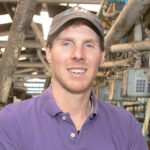Farmer Focus: Forage cropping tweaks should improve resilience
 Jonathan Hughes © Tim Scrivener
Jonathan Hughes © Tim Scrivener January brought some drier weather, allowing us to lift the last of the fodder beet and drill the remaining winter oats.
Last year was challenging for growing forage crops, with an arid start to spring followed by a sodden autumn harvest.
As farmers, it’s easy to blame the weather and raise concern, but it’s one factor we can’t control. We hope a robust cropping plan is something we can do to manage the risk.
See also: Why cutting concentrates is key to more milk from forage
Obviously, being organic restricts our options, as you can have less of an influence on manipulating growing crops, but, equally, it’s easier to shut the gate and walk away.
So, what will we change for this year? We had about 50ha (124 acres)of beet and wholecrop cereals destroyed by leatherjackets after lucerne and long-term grass.
Ploughing in the autumn and establishing cover crops will hopefully reduce the impact.
Those fields that haven’t been ploughed yet will wait until early spring to ensure the live root matter, on which the larvae feed, decompose by the time of drilling (late April for the beet).
We’ve found that a later drilling date has helped, because the warmer soil temperature speeds up establishment and reduces weed competition.
Conversely, we will drill a proportion earlier if conditions allow, to reduce the impact in a dry spring. Although costly, an early failed crop can always be redrilled.
Milk production has been great this autumn, peaking at 2.2kg milk solids a head (27 litres) in December, feeding about 7.5kg concentrate a cow, including 2.5kg a cow home-grown oats, which has helped keep a cap on high organic feed costs.
Autumn breeding has also (so far) been successful, as we enter week 11 of the 12-week block as I write.
From current pregnancy diagnoses, a promising six-week in-calf rate of 87% and 75% for the heifers and cows, respectively, is looking likely.
The improvement is likely due to a smoother transition, with greater focus on dry cow and fresh calver nutrition.
Interestingly, we had seven different artificial insemination techs in the first four weeks of breeding, which highlights a labour issue widespread across the industry.
This year, my brother Alistair and I have done more inseminations ourselves, and done everything from week four. Hopefully, we will be more in control next year.

